Referral Sales in Management Strategy Sales 1/3
“The balance of power is shifting toward consumers and away from companies.
The right way to respond to this if you are a company is to put the vast majority of your energy, attention, and dollars into building a great product or service and put a smaller amount into shouting about it, marketing it.
In the old world, you devoted 30% of your time to building a great service and 70% of your time to shouting about it. In the new world, that inverts. Your brand is formed primarily, not by what your company says about itself, but what the company does.”
Starbucks’ Howard Schultz also has similar thoughts on advertisement cost in what he wrote: “Starbucks’ success proves that millions of dollars of advertisement spending is not necessary in establishing a national brand.”
Both Jeff Bezos and Howard Schultz started out as venture businesses, and it is without a doubt that they climbed to the top to become successful businessmen through revolutionary business strategy.
Amazon officially started in 1995. Starbucks’ breakthrough could also be said to be in the 1990s. In other words, the traditional era of advertisement-centered sales has ended, and as they both said, right now is the time where rather than advertisement, product quality and word of mouth have become the main driving forces.
The Fall of Traditional Media Seen Through Data
The advertisement fee for the once-popular mass communication media—print media, broadcast media, outdoor media, and film—is declining annually. The number of copies of magazines has also declined, and the television industry also fails to record the same ratings it once had. Figure 1 is a summary of the advertisement fee growth for each business category.
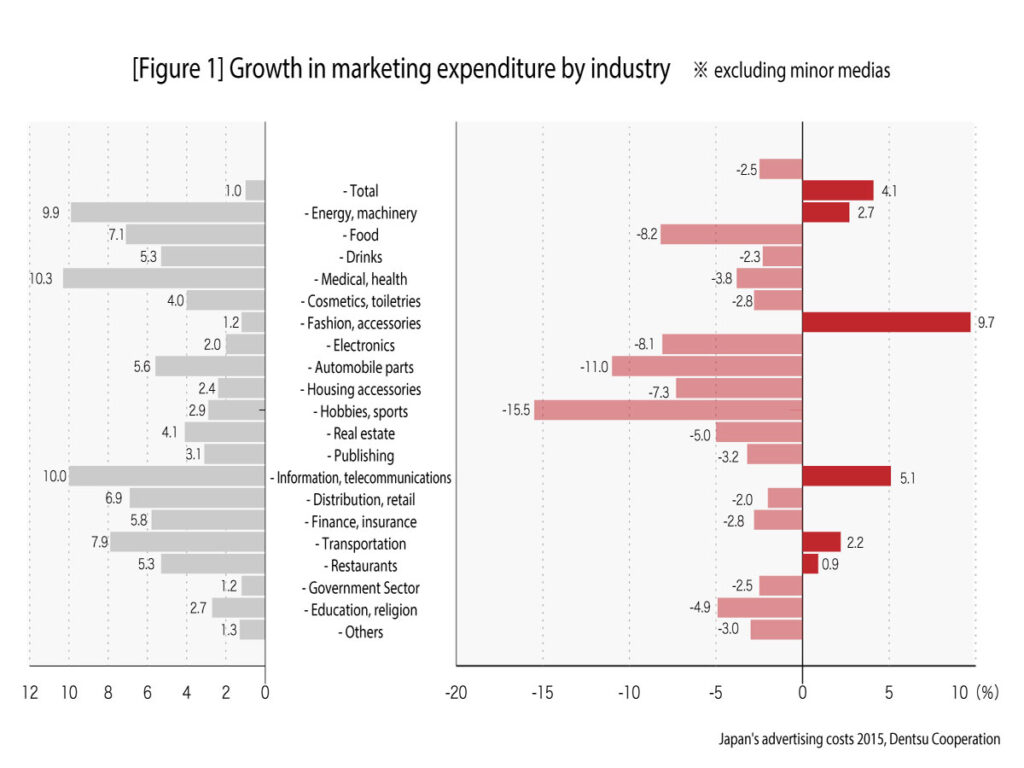
It can be seen that for most business categories, the advertisement fee for the four mass communication media has decreased.
This distribution involves deciding how much of the advertisement budget goes to each specific medium based on various factors.
The Rise of the Internet
A media that is growing in popularity and looking to replace the four traditional media is the internet. Due to the popularization of smartphones, the internet has become a media that is extremely familiar, especially for young audiences.
Thanks to the speediness of information and the interactive nature that the internet offers, many services, such as social networking service (SNS) or curation applications, have been developed.
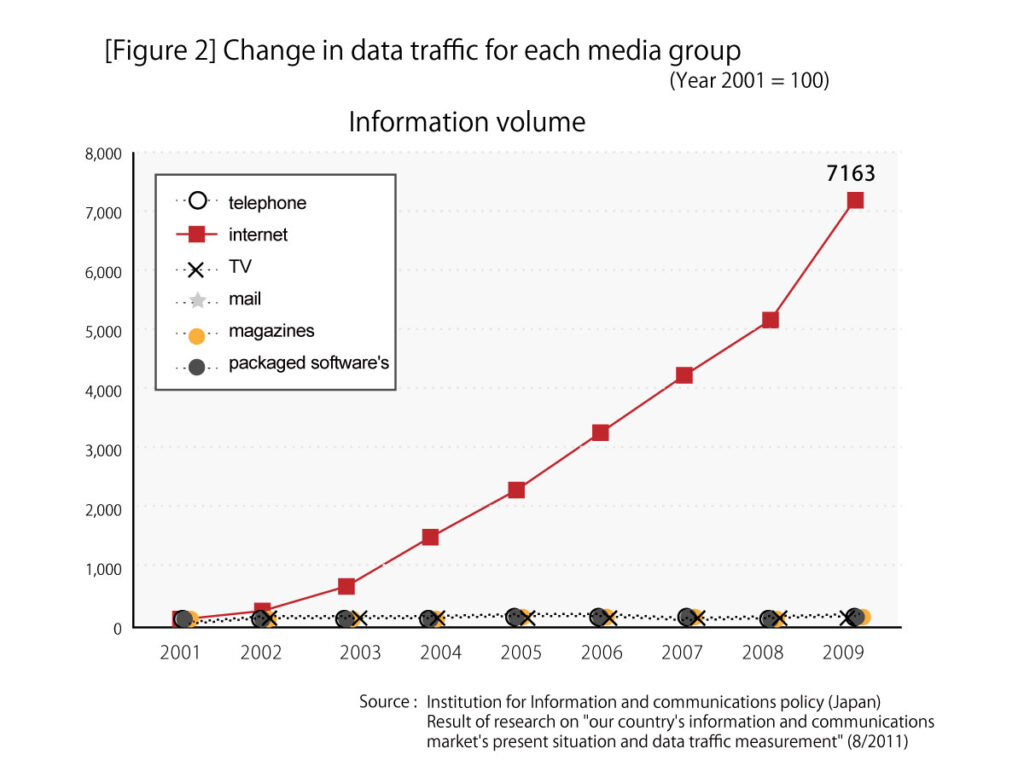
According to the documents by Japan’s Ministry of Internal Affairs and Communication (MIC) (Figure 2), if the data amount in 2001 equals 100, that figure would rise to 7,163 in 2009; consequently, the data amount increased by more than 70 times during a period of only 10 years.
However, there is a limit on the information amount one human can process. Due to the excess of information, which is more than one can fully grasp, information is processed in one moment and is suddenly forgotten and gone. In an information-flooded era like the present, how are people choosing which information to retain?
The Value of Information Lies in the Quality, Not Amount
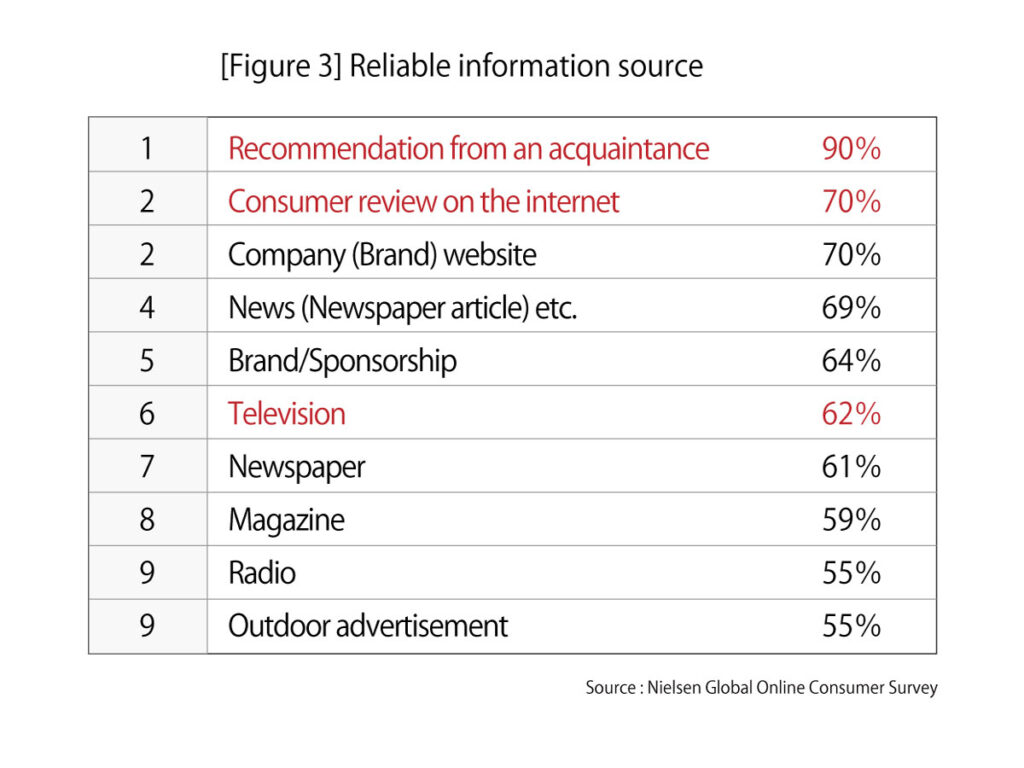
The following insights are from Nielsen’s survey in April 2009 (Figure 3) ranking the reliability of information sources:
No. 1: Recommendation from an acquaintance.
No. 2: Consumer review on the internet surpassed television or magazines. It can be seen that for consumers, referrals and word of mouth are reliable information sources.
Referrals from acquaintances, or word of mouth from a third party under similar circumstances are deemed highly reliable due to the proximal psychological distance or status.
It is not an overstatement to say that at present, referrals and word of mouth have surpassed the four main media, and are becoming one of the most reliable media for consumers.
Going Beyond CLV Maximization
In Asia, there are still many unexplored industries, and the growth of existing trade partners leads directly to the company’s growth.
It is a scheme in which the expansion of the existing trade partner’s business leads to a larger budget, resulting in the rise in trading value with the company, eventually leading to the company’s growth.
As was the case in Japan during its high-growth era, in this stage, by aiming for the maximization of CLV (customer lifetime value), substantial sales expansion could be anticipated. Shown below is a document for reference on CLV improvement (Figures 4, 5).
This is a document about Starbucks corporation’s customer satisfaction (CS) and CLV.
CS is the horizontal axis, while CLV is the vertical axis. From the graph, it can be observed that the higher the customer satisfaction is, the higher the number of store visits and purchase price.
Moreover, there is actually more than 3 times price difference in CLV between “satisfied” and “extremely satisfied” customers. Therefore, it can be seen that in order to maximize CLV, increasing the customer’s satisfaction is an important prerequisite.
What is CRV, an important index for referral and word of mouth strategy?
However, in a mature market such as Japan, all rival companies are already maximizing their CLV at a high level. In a situation where sales from existing customer hits a plateau, the current situation is that traditional CLV maximization alone could not differentiate the company from rivals, and does not lead to growth. Therefore, an index which takes one step further is necessary.
Hence, mature market such as the US are now currently focusing on maximizing CRV (Customer Recommend & Referral Value). CRV is an index which does not represent only the increase in sales from the customer whose satisfaction was increased himself, but it also takes into account the increase in sales from families, friends, and acquaintances from referral and word of mouth. In another word, the point lies in the efficiency of new customer acquisition through existing customers.
From the figure, among consumers who received word of mouth, more than 50% actually search for respective product or service, and more than 40% actually went to take a look at the product. In another word, it can be seen that word of mouths from an acquaintance easily leads to action.
The next graph (Figure 8) shows how word of mouth from acquaintances affects purchase price. From this, more than 50 percent of consumers answered that they would still purchase the item even though the price is 10% higher.
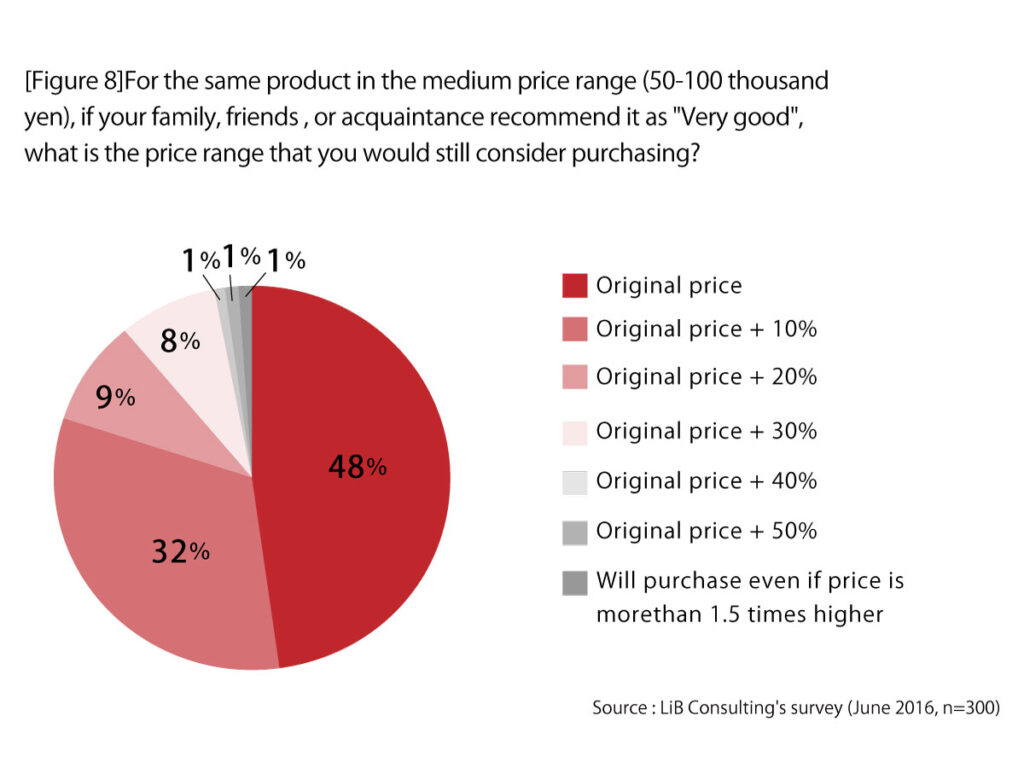
In other words, it can be seen that due to the high reliability of the information taken from a referral or word of mouth, it could easily lead to a purchase decision, and there is even a high probability that the item will be purchased despite it slightly being more expensive.
The overview of CRM from CLV and CRV
So, what must be done in order to increase referrals and word of mouth in future sales activities and maximize CRV?
Let’s think about this from a CRM (Customer Relationship Management) point of view.
Moving forward, for CRM, not only CLV but also the maximization of CRV must be considered.
Firstly, to increase CLV, it is necessary to enhance CS, which produces referrals and word of mouth, leading to increased CRV.
Enhancing the “Satisfied” state, as illustrated in the Starbucks’ example; creating an “Extremely Satisfied” state; and building customer relationships that easily lead to referrals and word of mouth are the conditions for CRV maximization. In doing so, the important things are as follows:
Aging Japanese companies favor the maximization of CRV
In recent years, Japanese companies have started to become aging organizations, and this was even thought to be the reason behind the decline in sales activity in the country.
However, for a sales strategy utilizing referrals and word of mouth, the aging of an organization could be beneficial. Even though aging sales organizations often lack the motivation to acquire new customers, they often possess better relationships with long-dealing existing customers compared to a sales organization with a younger population.
This again proves that this customer asset can be utilized in referral sales.
CRV maximization is an issue that should be applied to all business categories
Actually, there are companies in some business sectors that have already implemented CRV. From the B2C sector are real estate companies or car dealers and from B2B are system development or office equipment vendors.
In other words, these are businesses that have low purchase frequency. In contrast, currently, businesses with high purchase frequency are known to focus only on CLV (Figure 9). However, a growth strategy focusing only on CLV faces a high probability of slow growth in a declining population and aging society.
Therefore, the promotion of CRV maximization in these businesses is also important for effective customer acquisition.
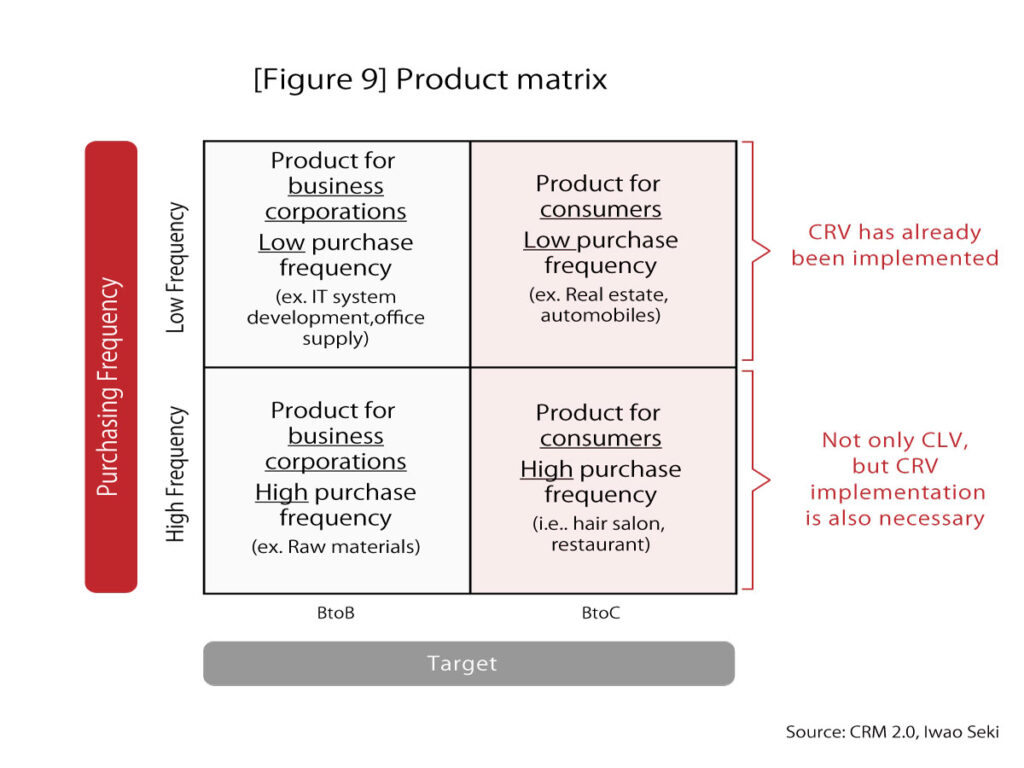
Thank you for your interest.
Please fill in some important information and we will be in touch.